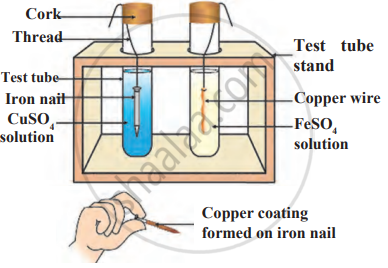Advertisements
Advertisements
प्रश्न
A metal M does not liberate hydrogen from acids but reacts with oxygen to give a black colour product. Identify M and black coloured product and also explain the reaction of M with oxygen.
उत्तर
Copper is the metal which does not react with acids to liberate hydrogen gas. With oxygen, it forms Copper Oxide.
Hence, metal M is copper and the black coloured product is copper oxide.
`2"Cu"("s") + "O"_2("g") -> 2"CuO"("s")`
APPEARS IN
संबंधित प्रश्न
What do you observe when silver nitrate is added to a solution of sodium chloride?
How will you obtain Silver chloride from silver nitrate.
Also give balanced equations for the reactions
What do you observe when Magnesium ribbon is burnt in oxygen.
Write the chemical equation for the event.
A reaction was brought about between ferric oxide and aluminum.
Select the correct answer for the statement given below:
A neutral oxide which does not react with an acid or a base to give salt and water.
Give a balanced equation for the following type of reaction:
A displacement reaction in which a metal above hydrogen in the reactivity series, displaces another metal from the solution of its compound.
Classify the following metals based on their reactivity.
Cu, Zn, Ca, Mg, Fe, Na, Li, Hg
| More reactive | Moderately reactive | Less reactive |
Observe the following diagram and identify the type of reaction and write observation.

Which of the following is the correct arrangement of the given metals in ascending order of their reactivity?
Zinc, Iron, Magnesium, Sodium
Three metal samples of magnesium, aluminium and iron were taken and rubbed with sandpaper. These samples were then put separately in test tubes containing dilute hydrochloric acid. Thermometers were also suspended in each test tube so that their bulbs dipped in the acid. The rate of formation of bubbles was observed. The above activity was repeated with dilute nitric acid and the observations were recorded.
Answer the following questions:
(i) When the activity was done with dilute hydrochloric acid, then in which one of the test tubes was the rate of formation of bubbles the fastest and the thermometer showed the highest temperature?
(ii) Which metal did not react with dilute hydrochloric acid? Give reason.
(iii) Why is hydrogen gas not evolved when a metal reacts with dilute nitric acid? Name the ultimate products formed in the reaction.
OR
Name the type of reaction on the basis of which the reactivity of metals is decided. You have two metals X and Y. How would you decide which is more reactive than the other?
